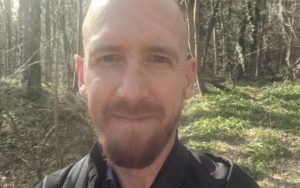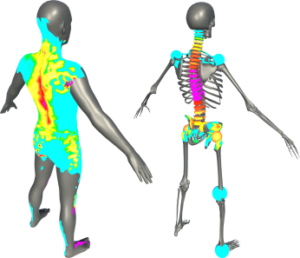James shares the challenges he faced after diagnosis and how he found a new career helping others living with axial SpA to show what their pain looks like on a day-to-day basis.
When I first started getting pain in my joints and spine, I was lucky enough to have a dad who worked in the NHS and knew straight away that I should see a rheumatologist. I was fortunate to be diagnosed quite quickly, first with undifferentiated spondyloarthritis, and later axial SpA.
But for several years after my diagnosis, I understated my pain. It was significantly affecting my life, but I told people that I was managing okay and it wasn’t that bad. For years, my friends, family and rheumatologist didn’t realise how much I was suffering inside.
There were a few reasons for this. At the time I was young, quiet and shy. I was the kid who preferred to spend time in his room reading, playing on my computer or painting miniatures rather than out socialising with friends, so explaining my feelings, especially ones that made me feel vulnerable, seemed really scary to me. But it was also the fact that I had no idea how to explain all the ups and downs; the nature of the pain, all it’s shifting qualities, how it moved around my body from hour to hour and day by day, the little flare-ups, the big flare-ups, the mysteriously good days, the brain fog, the feeling of having the flu but without having the flu, the random joint swellings – it all seemed too much to explain in words.
It just felt easier to ignore the AS, the fatigue and the pain, trying to live the life I thought I should be able to. But this didn’t last for long. Eventually, I was so worn down that I broke down and cried in front of my rheumatologist. This was probably one of the best things to happen to me because I was finally able to express some of what I was going through.
It was after that appointment that I got access to biologics, and my life changed. For some years, I felt so much better that I ran the Great North Run twice to raise money for NASS. I was able to work in IT, sometimes part-time and sometimes with extended periods of sick leave, but with great support from my employer and my newfound ability to express myself, I regained a sense of normality in my life.
Then the biologic I started on began to become ineffective, which was a devastating blow. It took a long process of trial and error to find another combination of NSAIDs, methotrexate and a different biologic which worked well. Sometimes it was really hard to tell if a new combination was better or worse, because my symptoms were so up and down, and brain fog made it hard to assess things objectively. But I eventually hit on a regimen that settled my symptoms down to a manageable level again.
It was during this process that I decided on a career change. Instead of trying to fit myself into a regular office job with fixed hours, I decided to take what I had learned over years of living with chronic pain and fatigue, and turn it into something good. I quit my job and eventually started my own company, Chronic Insights, where I could work my own hours and use my IT skills to build a symptom diary app.
It’s the best decision I ever made. After four years of working at home, I’m so proud of what I’ve achieved because it’s the app I wished that I had when I was younger. It’s a mobile app called Chronic Insights which allows people like us who have chronic pain to record their symptoms visually. By rotating a 3D manikin and “painting” your pain onto it with your finger, you can literally show people what your pain looks like day to day, and see a 3D heatmap of where you experience pain most frequently.
The messages I get from users telling me how much they like using it, and how it makes their pain more visible, are amazing. Knowing that the app I made is helping others communicate what their symptoms are really like means the world to me.
I’m now planning to use my experiences with AS in a different way: writing a novel with characters who have AS, fibromyalgia and other chronic health conditions, because I believe the lack of representation of people with chronic pain in media and literature is something that contributed to my loneliness and fear of talking about pain.
So, even though AS has been a dominating force in my life, in some ways I can feel grateful for it. It’s made me really think about what I’m doing with my life, and led me to a self-made career which has given me purpose, joy and fulfilment.

